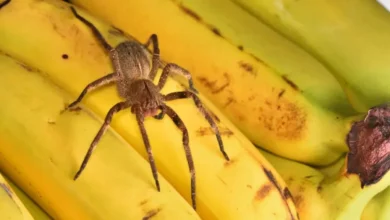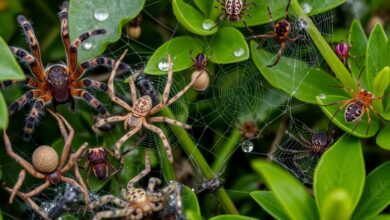Types of Black Widow Spiders Near You
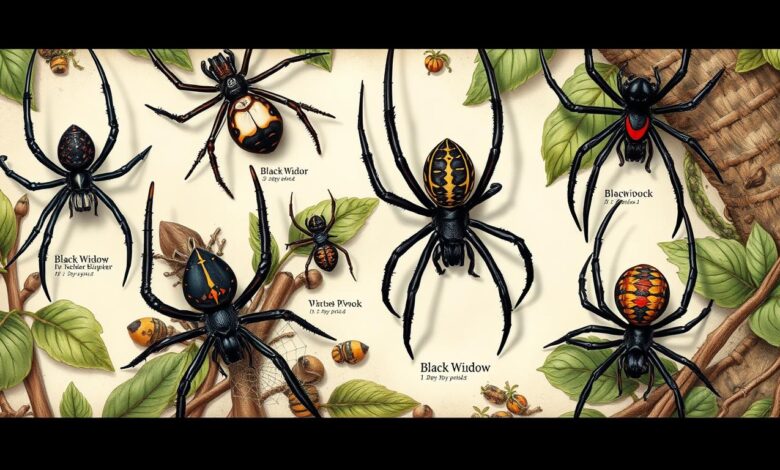
Black widow spiders are found all over North America. They stand out because of their black color and red hourglass on their belly. Knowing the different types of black widow spiders is key to staying safe.
There’s the Western black widow and the Northern black widow, among others. Each has its own look and where it likes to live. Knowing what black widow spiders look like in your area helps you avoid them.
Understanding the Venomous Black Widow Spider
The black widow spider is known for its red hourglass mark on its black belly. It’s one of the most venomous spiders in North America. Its venom can cause severe pain, muscle cramps, and nausea. In rare cases, it can even be deadly.
Recognizing the Distinctive Hourglass Marking
The red hourglass shape on the black widow’s belly is a clear sign. This mark helps tell it apart from other spiders. Black widows also have shiny black bodies and long, thin legs, making them easy to spot.
Potential Risks and Effects of a Black Widow Bite
A black widow bite is extremely dangerous. The venom can lead to intense pain, muscle spasms, and nausea. It can also cause breathing problems. If bitten, seek medical help right away.
| Symptom | Description |
|---|---|
| Pain and Muscle Cramping | The bite can cause severe, persistent pain and muscle spasms, often starting in the local area and spreading throughout the body. |
| Nausea and Vomiting | Black widow bites can lead to nausea, vomiting, and abdominal pain. |
| Respiratory Distress | In some cases, the neurotoxin can affect the respiratory system, making it difficult to breathe. |

If you think you or someone you know has been bitten by a black widow, get medical help fast. Quick treatment can help manage symptoms and prevent serious effects.
Common Black Widow Species Found in Your Area
In North America, the Western black widow and the Northern black widow are the most common. They both have black color and a red hourglass mark. But, they differ in looks and where they live.
The Western Black Widow (Latrodectus hesperus)
The Western black widow is found in the western U.S. and Canada. They like dry, dark places like woodpiles and sheds. Their venom is very strong and can hurt humans badly.
The Northern Black Widow (Latrodectus variolus)
The Northern black widow lives in the east and center of North America. They like cooler, wetter places like rotting logs. Their venom is strong too, but bites are less common.
| Species | Geographic Distribution | Habitat Preference |
|---|---|---|
| Western Black Widow (Latrodectus hesperus) | Western United States and Canada | Dry, sheltered areas like woodpiles, sheds, and dark corners |
| Northern Black Widow (Latrodectus variolus) | Eastern and central North America | Cooler, more humid environments like rotting logs and tree stumps |

Knowing the Western and Northern black widow spiders helps you stay safe. It’s key to know which ones are near you to protect your family and pets.
Identifying Black Widow Spiders by Their Web Patterns
Black widow spiders can be identified by their web patterns, not just their looks. Black widow webs are typically irregular and messy, with thick, strong strands. They build their webs in dark, sheltered spots like under logs or in woodpiles. Looking at the web’s structure and where it’s located can help you spot black widows.
Black widow spider webs look different from others. They are messy and have thick, strong strands. This lets the spider quickly catch prey. Unlike other spiders, black widow webs are found in hidden spots, making them hard to see.
| Web Characteristic | Description |
|---|---|
| Web Structure | Irregular, messy, with thick, strong strands |
| Web Location | Hidden, sheltered areas like under logs, in woodpiles, or in undisturbed corners |
By watching the web patterns and locations, you can find black widows more easily. Knowing about their webs and physical traits helps you stay safe from these venomous spiders.

Habitats and Hiding Spots of Black Widows
Black widow spiders like to hide in quiet places. They build their nests and webs in spots where they won’t be bothered. Woodpiles, sheds, and dark corners of buildings are their favorite hiding spots.
Garages, barns, and under porches are also popular spots for black widows. These areas are perfect because they are secluded, sheltered, and close to food.
Woodpiles, Sheds, and Dark Corners They Prefer
Woodpiles are a favorite of black widows. The logs and debris provide plenty of hiding spots and food. Sheds and outbuildings with dark corners are also great places for them to nest.
Black widows also like to hide in the cracks and crevices of buildings. These spots are dark and safe, allowing them to spin webs and lay eggs without being disturbed.
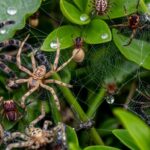 Arácnido (Spider): Fascinating Arachnids
Arácnido (Spider): Fascinating Arachnids
Knowing where black widows like to hide can help you stay safe. It lets you take steps to avoid these venomous spiders.
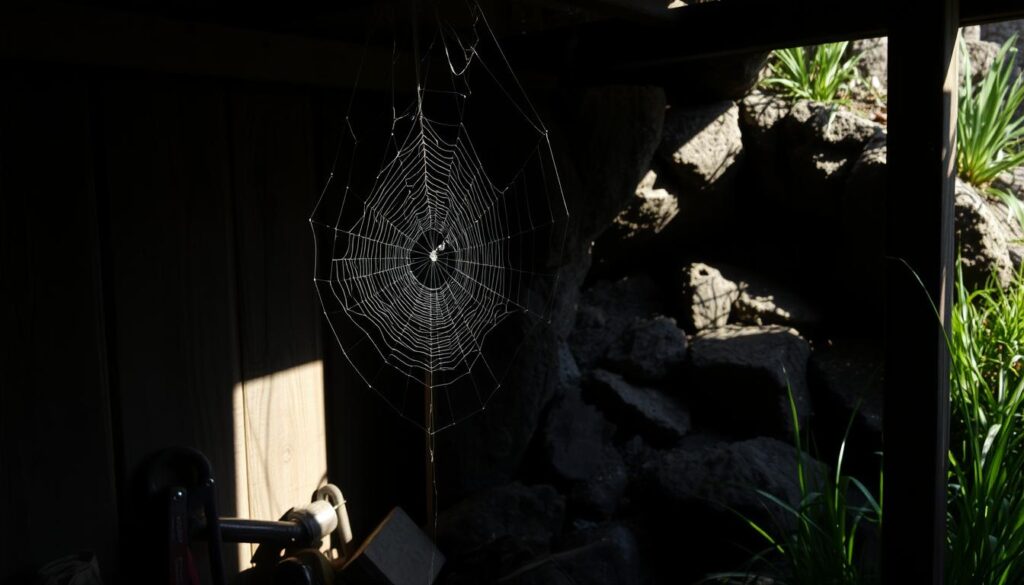
Natural Predators and Population Control of Black Widows
Black widow spiders are venomous, but they have natural enemies. Birds, lizards, and other spiders help keep their numbers in check. Weather and food also affect how many black widows there are in an area.
Users on iNaturalist have seen more wasps this year. The European paper wasp is common in Colorado. It’s aggressive and eats native insects.
People might think there are more spiders because black widows live together. But, they are shy and hide unless bothered. Only some people, like the very young or old, should worry about black widow bites.
| Natural Predators | Population Control Factors |
|---|---|
|
|
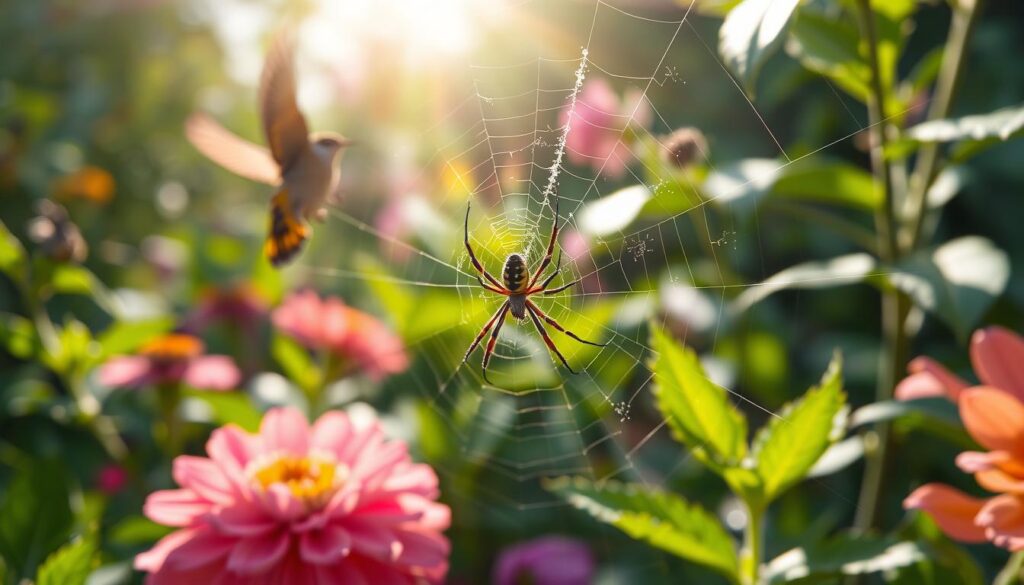
Black widow spiders might seem scary, but nature keeps them in balance. By understanding this, we can respect our ecosystems. We can learn to live with these interesting spiders.
Black Widow Spider Facts and Myths
There are many myths and misconceptions about black widow spiders. These myths often cause unnecessary fear and panic. But, knowing the facts can help clear up these worries and give a more balanced view of these fascinating spiders.
Debunking Common Misconceptions
One big myth is that black widows can jump. But, they can’t jump at all. They live on the ground and use their webs to catch prey, not by jumping after it.
Another myth is that black widow venom is the most toxic. While their venom is very toxic, it’s not the most venomous. The venom of the Brazilian wandering spider is actually more potent.
- Black widows are not naturally aggressive and only bite in self-defense when threatened or disturbed.
- Their webs are not as strong or large as often depicted in popular media, and they are not known to trap or ensnare humans.
- Black widows play an important role in the ecosystem, helping to control populations of other insects and arthropods.
By separating fact from fiction, we can better appreciate the true nature of these remarkable creatures and their place in the natural world.

| Fact | Myth |
|---|---|
| Black widows are not aggressive and only bite in self-defense. | Black widows are highly aggressive and will attack humans unprovoked. |
| Their venom is potent but not the most lethal of all spider species. | Black widow venom is the most deadly of all spiders. |
| Black widows are not capable of jumping or leaping at humans. | Black widows can jump several feet to attack people. |
| Black widows play an important role in controlling insect populations. | Black widows are a nuisance and should be exterminated. |
types of black widow spiders
The black widow spider is well-known and feared in North America. But, there are many types of black widows found in different places. Knowing the differences between these types of black widow spiders helps you identify them and know how to react if you see one.
The Western Black Widow
Latrodectus hesperus, or the Western black widow, is common in the western U.S. and Canada. They have shiny black bodies and a red hourglass mark on their bellies.
The Northern Black Widow
Latrodectus variolus, or the Northern black widow, lives in the northeastern U.S. and eastern Canada. They look like the Western black widow but have more varied hourglass colors, from red to orange or yellow.
The Southern Black Widow
Latrodectus mactans, the Southern black widow, is found in the southern and central U.S. They have black bodies and bright red hourglass markings.
| Species | Geographic Distribution | Hourglass Color |
|---|---|---|
| Western Black Widow | Western United States and Canada | Red |
| Northern Black Widow | Northeastern United States and Eastern Canada | Red, Orange, or Yellow |
| Southern Black Widow | Southern and Central United States | Bright Red |
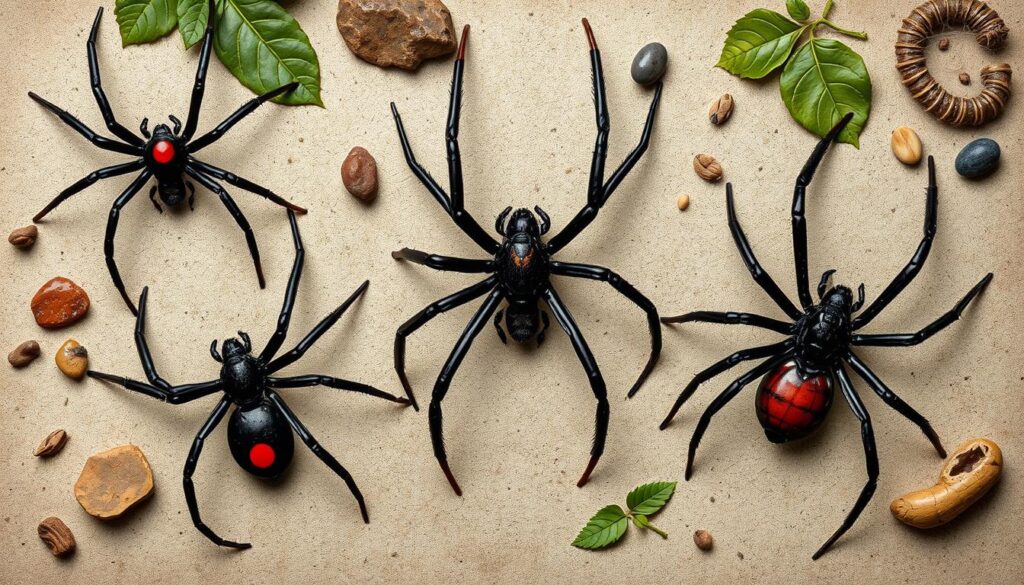
Seasonal Behavior and Activity Patterns
Black widow spiders show clear patterns in their behavior with the seasons. They are more active and visible when it’s warmer, especially in spring and summer. Studies reveal that spider activity goes up with warmer weather, peaking in the warmer months.
In winter, black widows are less active. They hide in nests or other spots to save energy. Their hunting and feeding slow down, making them harder to find at home. But when spring comes, they start hunting again, increasing the chance of seeing them indoors.
If you live where black widows are common, watch out more in spring and summer. These are their busiest times. To avoid them, seal up cracks, remove woodpiles, and use natural repellents like essential oils.
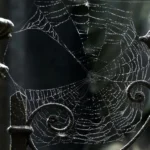 Spiders: Fascinating Creatures of the Arachnid World
Spiders: Fascinating Creatures of the Arachnid World
Regular pest control checks and treatments in warmer months can also help. Knowing when black widows are most active helps you protect your family. Stay alert and take steps to keep them away.
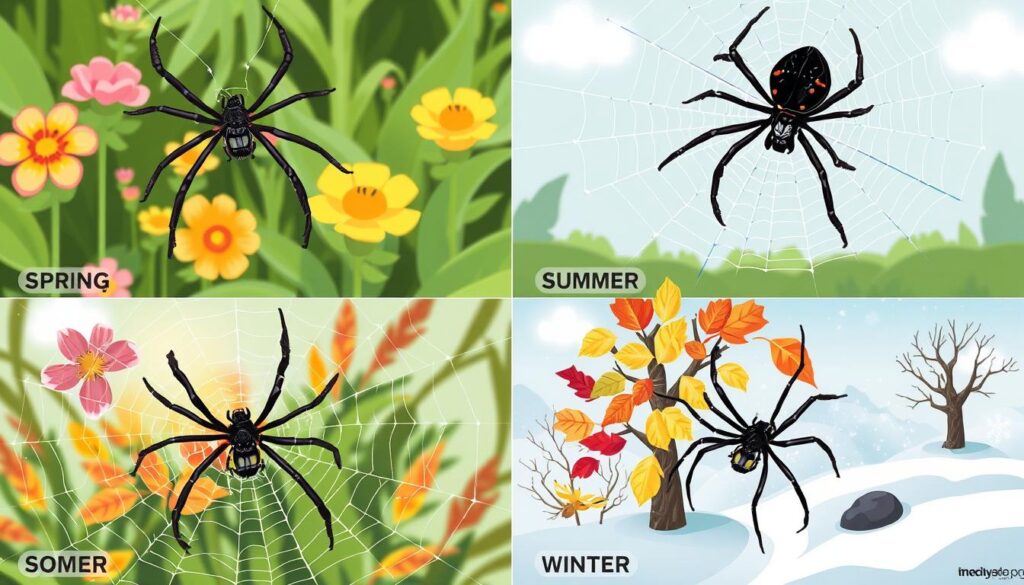
First Aid and Treatment for Black Widow Bites
If you’ve been bitten by a black widow spider, get medical help right away. The venom can be very dangerous and even life-threatening. So, getting professional treatment quickly is key.
While waiting for help, you can do some basic first aid. First, clean the bite with soap and water. Then, use a cold compress or ice pack to reduce swelling and pain. Stay calm and still to slow the venom’s spread.
Seeking Immediate Medical Attention
Even if the bite doesn’t seem bad at first, you need a doctor’s care. Symptoms like muscle pain, nausea, and trouble breathing can get worse fast. Getting medical help quickly is crucial for a full recovery.
At the hospital, you might get antivenom to fight the venom. You might also get pain meds, fluids, and monitoring. With the right care, most people get better without lasting harm.
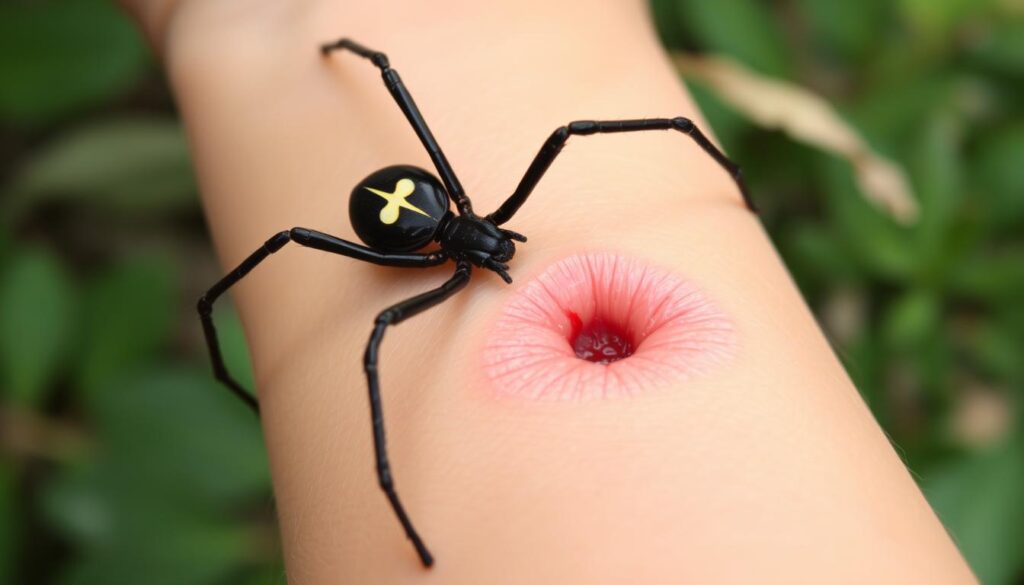
Remember, time is crucial with black widow spider bites. Get medical help fast and follow your doctor’s advice for the best results.
Preventive Measures to Avoid Black Widow Encounters
To stay safe from black widow spiders, take proactive steps. Start by checking and cleaning outdoor spots where they might hide, like woodpiles and sheds. Wearing gloves and long sleeves when outdoors can also help avoid bites.
It’s important to know how to spot black widows and what they like. Learning about their hourglass shape and where they live can protect your family.
- Regularly inspect and clean woodpiles, sheds, and other dark, cluttered areas around your home.
- Wear protective clothing, such as gloves and long sleeves, when working in outdoor spaces.
- Educate yourself and your family on the identification and behavior of black widow spiders.
By following these steps, you can lower the risk of a black widow encounter. Being proactive and informed is key to avoiding their venomous bites. Stay safe and know your surroundings to avoid these spiders.

| Preventive Measure | Description |
|---|---|
| Regularly inspect and clean | Regularly inspect and clean outdoor areas, such as woodpiles, sheds, and dark corners, where black widows may hide. |
| Wear protective clothing | Wear gloves and long sleeves when working in areas where black widows may be present to reduce the risk of getting bitten. |
| Educate yourself and your family | Learn to identify the distinctive hourglass marking on black widows and understand their preferred habitats to stay vigilant and avoid encounters. |
Professional Black Widow Spider Control and Extermination
If you think you have black widow spiders in your home, it’s smart to call a pest control expert. They know how to safely get rid of black widow spiders. Trying to do it yourself can be very dangerous.
Female black widow spiders can have hundreds of babies quickly. They use their webs to catch food. Destroying their webs is key to stopping them.
Experts use special ways to find and kill black widow spiders. They might use insecticides, remove webs, and change the spiders’ homes. They wear special gear to avoid getting bitten.
Working with a black widow spider control service means your home will be safe. You won’t have to worry about these dangerous spiders anymore.
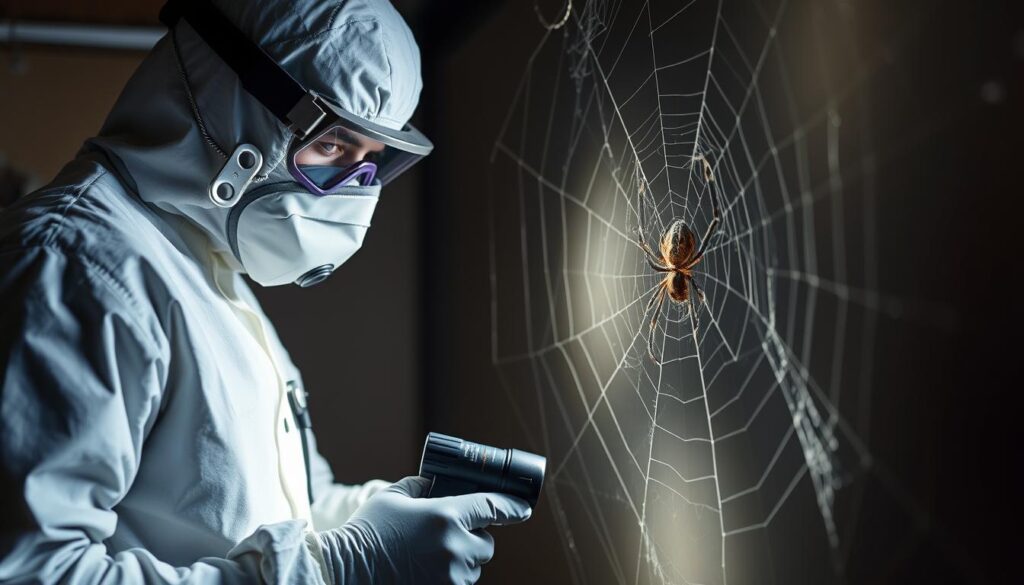
Impact of Black Widows on Local Ecosystems
Black widow spiders might seem scary, but they’re actually important for our ecosystems. They help keep other insects and small animals in check. This keeps the food chain healthy.
Their presence can also tell us about the environment’s health. They do well in places with lots of food and good homes.
Learning about black widows can help us see them in a new light. They’re key to controlling pests and keeping biodiversity. Think about the good they do before trying to get rid of them.
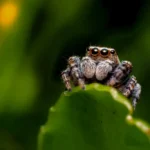 Jumping spiders Nature’s little acrobats
Jumping spiders Nature’s little acrobats
Black widow spiders are a natural part of many places. With safety steps, we can live with them. By understanding their role, we help our ecosystems thrive.

